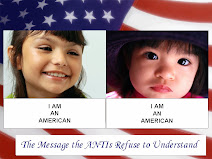 More and more ANTI sites are opposing the SAVE ACT due to its e-Verify-RealID provisions. The latest site defines the details of the RealID Act. Click here and then on "What Is ´Real ID´for the details.
More and more ANTI sites are opposing the SAVE ACT due to its e-Verify-RealID provisions. The latest site defines the details of the RealID Act. Click here and then on "What Is ´Real ID´for the details.Let us sum up the provisions of the Real ID Act:
1. All state-issued driver's licenses and non-driver ID shall include a "biometric parameter," commonly understood to mean fingerprints, from at least two of the identified person's fingers. This will result in a dramatic increase in the number of people fingerprinted and in the size of computerized fingerprint databases. Currently, fingerprinting is common in conjunction with arrests, as well as for certain forms of employment, but is not usually required for a driver's license. 
2. All of the above-mentioned documents are to include a "common machine-readable technology," understood to mean that the cards will be swipe-able like a credit card, and that all of the information encoded on the card would be available to the owner of the card-reading machine. The legislation itself does not specify whether only government agencies or private persons such as bar owners checking the age of patrons would have access to the encoded data, but "common" does imply that the authorities in California would be able to read licenses from New York, so the card-reading machines would have to be pretty generic. The Department of Homeland Security is pushing for the introduction of RFID chips, also known as "proximity chips," into licenses and ID cards, which enable anyone with the right instrument to read the card while it is still in its owner's pocket. The Digimarc Corporation has already sold systems for "contactless" smart card driver's licenses to North Carolina and other states. Digimarc touts the smart card licenses for their ability to be scanned by border authorities on the Mexican and Canadian side, more or less the way tolls are paid via Easy Pass at bridges and tunnels, at quite a distance.

2. All of the above-mentioned documents are to include a "common machine-readable technology," understood to mean that the cards will be swipe-able like a credit card, and that all of the information encoded on the card would be available to the owner of the card-reading machine. The legislation itself does not specify whether only government agencies or private persons such as bar owners checking the age of patrons would have access to the encoded data, but "common" does imply that the authorities in California would be able to read licenses from New York, so the card-reading machines would have to be pretty generic. The Department of Homeland Security is pushing for the introduction of RFID chips, also known as "proximity chips," into licenses and ID cards, which enable anyone with the right instrument to read the card while it is still in its owner's pocket. The Digimarc Corporation has already sold systems for "contactless" smart card driver's licenses to North Carolina and other states. Digimarc touts the smart card licenses for their ability to be scanned by border authorities on the Mexican and Canadian side, more or less the way tolls are paid via Easy Pass at bridges and tunnels, at quite a distance.
3. In order to obtain a driver's license, a real geographical address will have to be provided, not a post office box. This will essentially bar homeless people (or people whose home is their car) from obtaining licenses.
4. The Real ID Act requires states to link the databases of information on their issued IDs into a national database and to share this data with Federal law enforcement officials, as well as those from other states, and from Canada and Mexico.
5. Real ID includes several provisions that do not pertain to identification at all, but to immigration policy. One of these deprives state and local authorities of the right to use their own zoning or eminent domain provisions to interfere with the building of the border fence that is intended to hinder illegal immigration. Another allows the Department of Homeland Security to arbitrarily define the meaning of the word "terrorist" when deciding who shall and shall not be allowed to enter the country. This provision will probably be used to restrict the ability of non-citizens opposed to U.S. policies on a whole range of issues to travel in and out of the country, effectively cutting off the free exchange of information on those issues.
5. Real ID includes several provisions that do not pertain to identification at all, but to immigration policy. One of these deprives state and local authorities of the right to use their own zoning or eminent domain provisions to interfere with the building of the border fence that is intended to hinder illegal immigration. Another allows the Department of Homeland Security to arbitrarily define the meaning of the word "terrorist" when deciding who shall and shall not be allowed to enter the country. This provision will probably be used to restrict the ability of non-citizens opposed to U.S. policies on a whole range of issues to travel in and out of the country, effectively cutting off the free exchange of information on those issues.
USID LEGEND: 1. USID number = SS #; 2. Optical Memory Strip (like small CD) for digitized fingerprints and personal information; 3. Photograph; 4. Smart Card Technology (the card can perform data manipulation and run cryptographic algorithms, include medical history but could include travel history, education, work histories, other histories); 5. Internal Memory Strip (A high-capacity device could store rich biometric data such as several fingerprints, iris scans, face scans, heartbeat characteristics, or DNA sequences); 6. 2-D Bar Code: This low-tech info coding could be used by officials who don't have more sophisticated optical reading devices.






























